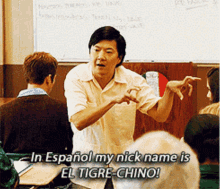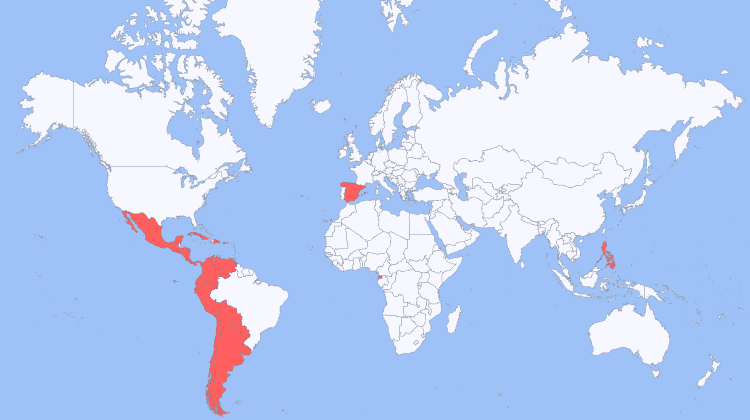There are 21 Spanish-speaking countries in the world with over 500 million speakers. It’s no wonder that Spanish ranks as the fourth most spoken language in the world. They can’t all come from one place, so that begs the question: what are all the Spanish-speaking countries, exactly? We’re glad you asked.
Spanish is a global language spoken from Asia to the Americas to Africa. That’s pretty impressive. But Spanish didn’t always naturally develop as the language of choice for these millions of people but thanks to centuries of complex history, the Spanish alphabet and language have found their way around the world.
Whether you already speak to your family in Spanish or are just starting a second language, this article will touch on the history of Spanish-speaking countries and how these areas have adopted and made them their own.
No time to waste, vamos!

How Many People Speak Spanish?
The standardized Spanish language we know today was formed in the 1200s. But what happened before that? It originated on the Iberian Peninsula which includes present-day Spain and Portugal and evolved from Vulgar Latin. mix the Arabic dialect spoken by the Moors, who colonized parts of the region, and the continuation of Vulgar Latin then boom! You’ve got modern-day Spanish.
But how did that lead to other Spanish-speaking countries? Spanish was brought to the Americas by conquistadors led by Christopher Columbus. You’ve probably heard of him. it spread rapidly throughout North, Central, and South America and the Caribbean. It was so prolific that not even Spain, the birthplace of the language**, has the largest Spanish-speaking population** anymore.
The Spanish spread to Asia, specifically the Philippines, took a bit of time. After much resistance from the Philippine people, the first permanent Spanish settlement was established which led to the entire country succumbing to Spanish rule. With More Spanish people arriving from Mexico and Catholicism establishing control of the government and everyday life, the combination assured a solid Spanish influence in the Philippines that lasted for centuries and still lingers today.
Out of all the Spanish-speaking countries, Africa might surprise you. What’s even more surprising is that it’s probably not the country you might think of. Western Sahara was colonized by Spain in the 1800s but has chosen not to continue Spanish as the official language. However, you can still put your language skills to the test as there are still many who speak Spanish there. Not many people know that Spanish is Equatorial Guineas’ official language. It’s not even the closest African country to Spain; it is however the only African country that communicates using the Spanish language with approximately 67.7% of the population speaking Spanish.
Below we will look at all the Spanish-speaking countries in more depth.
Source: YouTube (Different types of Spanish | Spanish Lessons)
All of the Countries that Speak Spanish

Spanish speaking countries: The 21 countries with Spanish as the official language include Argentina, Bolivia, Chile, Colombia, Costa Rica, Cuba, Dominican Republic, Ecuador, El Salvador, Equatorial Guinea, Guatemala, Honduras, Mexico, Nicaragua, Panama, Paraguay, Peru, Spain, Uruguay, and Venezuela, also Puerto Rico.
Europe
Just like an English speaker from Britain can understand an English speaker from America, the same applies to Spanish-speaking countries. In Spain, the language is called Castilian. The place where the Spanish language is believed to have originated from.
European Spanish is considered a seductive language to non-native speakers. Just listen to any Spanish pick-up lines and you’re bound to swoon. A distinct feature of the Castilian accent is the treatment of “s” sounds, it is known as the “Castilian lisp.”
Slang words can also be peculiar for non-native speakers. For example, if hear somebody exclaim, “¡Es la caña!” it usually means “That’s awesome!” but if you take its literal translation it means “That’s the fishing pole!” strange right? Another example would be “dar la lata” means “to irritate” or “to bother” but the literal translation of it would be “give the can.”
There are a sheer number of conjugations that exist for different pronouns in Castilian Spanish. Comparing it to Latin American Spanish, Castilian Spanish has an extra set of verb conjugations. It is called “vosotros” and is used as a second-personal plural pronoun.
| Country | Flag | Population | Capital |
|---|---|---|---|
| Spain | 🇪🇸 | 47 million | Madrid |
| Andorra | 🇦🇩 | 77 thousand | Andorra la Vella |
| Gibraltar | 🇬🇮 | 33 thousand | Westside |
Latin America
Latin American Spanish is very different from the Castilian Spanish spoken in Europe. Firstly it’s referred to as español which is a direct translation of Spanish. Although both kinds of speakers are able to communicate with each other there are many rules and differences that set them apart.
There are many accent and pronunciation differences Even within the same country with certain letters sounding different. in Latin America, the Canary Islands the letters “z” and a “c” are pronounced like an “s” but only if they sit before “e” and “i” in a word. If you compare it to Castilian Spanish it is pronounced like the English “th”.
We’ve established that there are differences even between Spanish-speaking countries within the same continent. For example in other Latin American countries, the letters ‘ll’ and ‘y’ sound like the English ‘y’ but in Argentina and Uruguay, they are pronounced like the English sound ‘sh’.
When referring to a group of people also grammatically known as the second person plural, Latin American speakers use ‘ustedes’. This essentially means that this kind of Spanish has five forms of conjugations.
We can’t talk about Latin American Spanish without talking about slang. In Argentina, slang is so entrained in society that they even have a word for it called ‘lunfardo’. across Latin America “Buena onda” translates to “good waves” or “vibrations” if you translate it to English it is similar to the term “good vibes”. If you’re trying to flirt or make your romantic advances know to someone you would say “tirar los galgos” which translates to “having the dogs after you”
| Country | Flag | Population | Capital |
|---|---|---|---|
| Argentina | 🇦🇷 | 46 million | Buenos Aires |
| Bolivia | 🇧🇴 | 12 million | La Paz |
| Chile | 🇨🇱 | 19 million | Santiago |
| Colombia | 🇨🇴 | 51 million | Bogotá |
| Costa Rica | 🇨🇷 | 5.1 million | San José |
| Ecuador | 🇪🇨 | 18 million | Quito |
| El Salvador | 🇸🇻 | 6.5 million | San Salvador |
| Guatemala | 🇬🇹 | 17 million | Guatemala City |
| Honduras | 🇭🇳 | 10 million | Tegucigalpa |
| Nicaragua | 🇳🇮 | 6.7 million | Managua |
| Panama | 🇵🇦 | 4 million | Panama City |
| Paraguay | 🇵🇾 | 7 million | Asunción |
| Peru | 🇵🇪 | 33 million | Lima |
| Uruguay | 🇺🇾 | 3 million | Montevideo |
| Venezuela | 🇻🇪 | 29 million | Caracas |

Africa
It’s pretty spectacular that Equatorial Guinea, a country found in central Africa, is the only country in Africa where Spanish is an official language. There are three official languages in this country Spanish, the other two are Portuguese, and french.
The Spanish used in the country is known as “Equatoguinean Spanish” like all dialects with geographical differences, Equatoguinean Spanish differs from the dialects of Spanish that are used in other spanish speaking countries like South America and Spain. The Spanish language has become the preferred language in administration and education with about 67.26% of the population being spanish speakers.
We have to take into account that, like in every African country, native languages influence each individual’s pronunciation and grammar. Equatoguinean Spanish is no different with linguistic diversity resulting in a great deal of variation compared to other Spanish-speaking countries.
There are specific variations in pronunciation in Equatoguinean Spanish compared to Latin American or Castilian Spanish. The ‘s’ at the end of a syllable or word is either strongly pronounced or sometimes omitted. ‘D’ sounds like ‘r’ and there’s typically no distinction between ‘r’ and ‘rr’. It’s not always cut and dry as linguistic diversity varies greatly between speakers.
Equatoguinean Spanish mix ‘usted’ and ‘tú’ when addressing people this is because Spaniards in colonial times would expect locals to address them more formally while addressing the locals more informally.
There are noticeable inconsistent subject-verb agreements as word stems and verb conjugations tend to vary in Equatoguinean Spanish attributed to the colonial inquisition.
The use of prepositions is interchangeable and sometimes altogether omitted. For example, “vamos en (in) escuela” could be stated to mean “we’re going to school” rather than “vamos a la escuela.”
Slang is not as popular in Equatoguinean Spanish as it is compared to other Spanish-speaking countries. In saying that, there are some phrases that are considered slang in comparison. “Antéose” is used to mean “I don’t know”. You can use it when you are asked Spanish question words you are not sure of. “Añambe” is slang for the expression of the English “Oh my god!”
| Country | Flag | Population | Capital |
|---|---|---|---|
| Equatorial Guinea | 🇬🇶 | 1.4 million | Malabo |
USA
This form of Spanish is very simply called Mexican Spanish. Easy to remember. We know that Spanish varies between countries and Mexican Spanish is no different. There are numerous grammatical deviations in this form of Spanish, the most obvious being the use of second-person pronouns. Regardless of the level of familiarity involved the informal ‘vosotros’, which is commonly used in European Spanish is never used instead the formal ‘ustedes’ is used at all times. Another noticeable difference has to do with verb tenses. Mexican speakers will generally use a simple past tense instead of the present perfect tense.
While there are many differences between Spanish and Mexican vocabulary There is a good chance native speakers will understand you regardless of which words you use. Some examples of vocabulary differences between Mexican Spanish and European Spanish would be: “Potato” in Spain is “patata” and in Mexico “papa.” The word for “computer” in Mexican Spanish is very similar to the English: “computadora. However, in Spain the word is “ordenador.”
Pronunciation differs greatly compared to other forms of Spanish. Spanish from Spain tends to be more guttural, this can be attributed to its Arabic influences whereas Mexican Spanish is softer. ‘z’ and ‘c’ before an ‘i’ or ‘e’ is pronounced like an ‘s’ sound in Mexican Spanish.
The Slang used in Mexican Spanish is truly entertaining. ‘¡Aguas!’ translated literally means “waters!”, but is used to mean “careful!” or “watch out!” ‘Estoy crudo’ is used to mean “I’m hungover” but translates to “I’m raw.” “¡Qué padre!” is used like the English expression “how cool!”, “How awesome!” or ‘that’s great! But if you translate it directly it means “how father!” which is rather nonsensical.
| Country | Flag | Population | Capital |
|---|---|---|---|
| Mexico | 🇲🇽 | 130 million | Mexico City |
| United States | 🇺🇸 | 332 million | Washington, DC |

Asia
Spanish in Asia is not as common as it once was, nevertheless, it still exists today. It is known as Spanish ceorle, or more specifically Chavacano in the Philippines. The current popular language in the Philippines is called Tagalog. Chavacano combines vocabulary mainly from Spanish, with grammar mainly from Tagalog. There are two main varieties of Spanish in this Asian country.
There is a formal variety that contains more Spanish vocabulary, and an informal variety containing more vocabulary from Tagalog and other Philippine languages. In total there are 6 dialects but the two most common ones are called the Zamboanga dialect and the Cavite dialect which stem from different regions. There is not much that differentiates European Spanish from Chavacano besides grammar.
Chavacano is going through a new evolution of slang. The most popular thing that has come out in recent times is the use of the word ‘caray’. You can use it whenever you wish to say that something or someone looks like something. For example “Caray Pesao” means that “(Something) looks heavy”
| Country | Flag | Population | Capital |
|---|---|---|---|
| Philippines | 🇵🇭 | 111 million | Manila |

FAQs
Being the 4th most spoken language in the world it’s fair to assume that there are numerous Spanish-speaking countries. In total there are 21 countries that consider their official language to be Spanish.
Apain does not hold the largest amount of native Spanish speakers but rather Mexico has the most Spanish speakers with 110 million speakers. In fact, Spain doesn’t even rank in the top 5 of the largest Spanish-speaking countries.
The smallest Spanish-speaking country shouldn’t come as a surprise. It’s by far Equatorial Guinea. With Around a third of the population in Equatorial Guinea speaking Spanish and being among the least-visited countries in the world it’s no wonder that this Spanish-speaking country is the smallest on our list.
Source: YouTube (What’s the difference between Spanish in Mexico, Latin America, and Spain?)
Let’s Explore Spanish Countries Together!
Now we know that Spanish is everywhere. Right in your backyard. If you weren’t convinced about learning the language you should be now.
We’ve learned about the history of the language across all continents and how they developed to become the various dialects they are today. We’ve also learned what to expect from each dialect. So if you are looking to learn a new language, trying to understand the country already established around you, or just looking to understand whether the Spanish nicknames you were called were compliments, there are an abundance of resources around you.
Don’t waste any time trying to learn a language all by yourself. Finding a private tutor will speed up the process to fluency lickety-split.
There’s no point in scouring the internet looking for a tutor that can check all your boxes. AmazingTalker has matched up to over 2 million students with the perfect tutor.

















